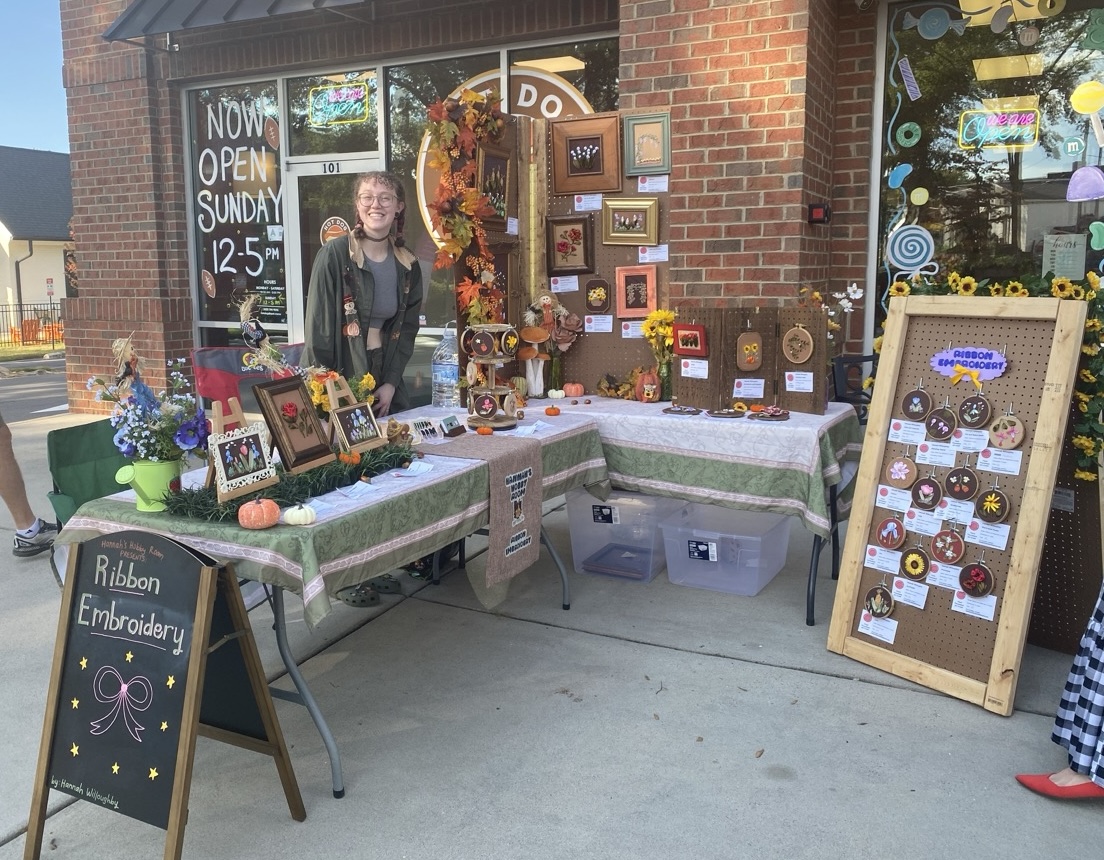
Getting Back Into Ribbon Embroidery
5 Original Works by Me
After years of traditional embroidery and cross-stitch, I’ve recently rediscovered the joy of ribbon embroidery. This dimensional technique transforms ordinary embroidery into stunning, textured pieces that quite literally pop off the fabric. Not only is it a great way to add texture to your embroidery, but it also allows you to use a wider variety of materials than just thread.

My Work
Basket Bouquet

This was my first piece. I used satin ribbon for the pansies, sheer ribbon for the coneflowers, thread for the baby’s breath, and jute ribbon for the basket.
If I were to remake this piece, I would:
- Improve the way I did the pansies by using bigger stitches for the top petals, as well as using finer black thread for petal detail.
- Use a different texture or color of ribbon for the basket, as well as a different stitch/combination of stitches. I’d probably use a thinner ribbon as well.
Daisies and Roses

This was my second piece. I used sheer ribbon for the daisies and satin for the roses and leaves. I used thread for the stems, vines, and butterflies. I used tulle for a green effect at the base of the flowers.
If I were to remake this piece, I would:
- Use satin ribbon for the daisies. They were sold out of satin when I went to the store for the ribbon for this piece. I might even just go over the daisies with the satin ribbon now that I have it and haven’t framed this piece yet.
Cherry Blossoms

This was my third piece. I used satin ribbon for the flower petals and the leaf, and I used thread for the stems and petal details.
For the stem, I used 6 strands of a dark brown thread, and then added a single strand of brown-gold thread. This gave the stem an effect of light reflection off of it, giving it even more texture. To stitch it, I used the stem stitch.
As for the petals and leaf, I used the “ribbon stitch”. This gives the petals a look of curling outward.
Irises

This was my fourth piece. I used satin and sheer ribbon for the flower petals, and thread for the stems. I had found this really interesting velvet ribbon, so I used it for the leaves to give them a different texture. I used gold thread for the detail on the petals.
To stitch the petals, I used a combination of the ribbon stitch and the chain stitch. I used the ribbon stitch for the leaves.
Just a couple details I would change if I were to remake this piece:
- Use more strands of the gold thread for the petals since it’s not very noticeable with just the single strand.
- Use the stem stitch for the stems instead of a straight stitch.
Pansies

This was my fifth piece. I used satin ribbon for the flower petals and leaves, and thread for the stems.
To stitch the petals, I used the ribbon stitch, including for the black details. I used a french knot for the center of the flower.
For the leaves, I used a variant of the ribbon stitch in which you place the ribbon through a side of the ribbon rather than the center. This gives the leaves a look of drooping or curling in a certain direction.
What I might still change about this piece:
- Remove the black detail from the petals and replace it with 6-strand black thread to give it even more detail.
- Use the stem stitch for the stems instead of a straight stitch.
Yellow Jessamine

This was my sixth piece. I used satin ribbon for the flower petals and leaves, and thread for the vine, an actual stick for the stake, velvet ribbon for the pot, and thread for the butterflies.
To stitch the petals, I used the ribbon stitch.
My favorite thing about this piece is the way the yellow ribbon pops in contrast to the reddish pink velvet pot and the dark red butterflies. This one is definitely my favorite out of all the pieces I’ve done so far!
What’s Next?
Here are a few ways I’d like to improve my ribbon embroidery:
- Practice more difficult stitches
- Make more complex pieces
I’m not sure what I’m going to do with these pieces yet. I still need to frame and finish them to be ready for display. At any rate, I’m glad to be working on something more textured and less time-consuming than my usual cross stitch.





Comments